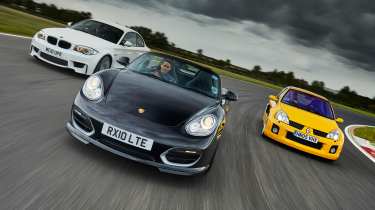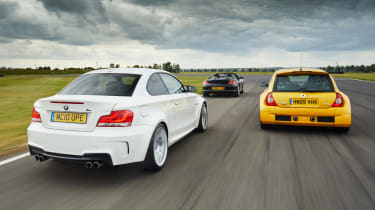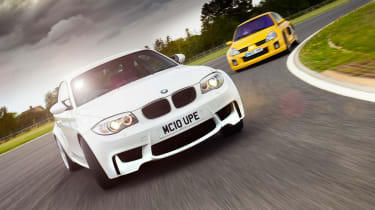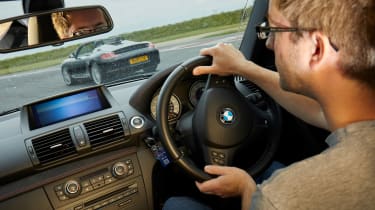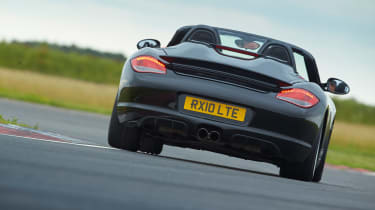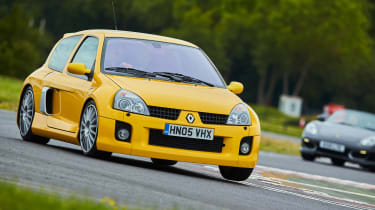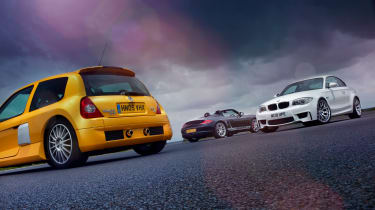BMW 1M v Porsche Boxster Spyder v Renault Sport Clio V6
These three evo icons are powered by three very different six‑cylinder engines and deliver three highly diverse driving experiences. We get reacquainted with the fabulous BMW 1M, Porsche Boxster Spyder and Renault Sport Clio V6
'Never judge a book by its cover.' Advice as relevant in life as it is in literature, but just this once, we suggest you freely ignore it. Each of these cars drives exactly as it looks. There’s the brawny, muscular one. The precise, tactile one. And the quirky, slightly experimental one. Names are barely necessary in this company. But if each really was a book, you’d be sold as soon as you clocked it on the shelf.
‘Brawny and muscular’ is the BMW 1-series M Coupé, better known as the 1M. This was the car that promised a return, of sorts, to the ethos of the original M3. At the time of the 1M’s launch in 2011 the M3 was in its fourth generation and packed V8 power, but it was also further than ever from the light and compact car that began the lineage.
The reception for the 1M was mixed, much of it centring around the choice of engine: firstly, it was turbocharged, as only the dubious X6M had been in the M model range until then, and secondly, the 335bhp 3-litre in-line-six N54 unit that BMW chose was not a ‘true’ M engine. Were it not for the cover art – flared arches covering 74mm and 46mm wider front and rear track widths, quad tailpipes, skeletal motorsport wheels – people might not have been as inclined to discover the story within.
‘Precise and tactile’? That’s the Porsche Boxster Spyder, of 987 vintage. Much like today’s Spyder, the 987 was the open-topped equivalent of the most focused Cayman available, in this case the Cayman R. It was 80kg lighter than a Boxster S at 1275kg, thanks to a DIY roof arrangement, selected aluminium panels and the omission of some equipment, while a small power bump – by 10bhp to 316bhp – helped justify the extra cost.
As with the 1M, the Spyder wore several visual cues to separate it from cooking Boxsters, most obviously apparent in the sculpted rear deck and its echoes of the 550 Spyder and the Carrera GT. The manual soft-top is secured by the windscreen header rail at the front and a pair of bright red eye hooks either side of the deck, and the vestigial arrangement even has its own speed limit – 124mph, rather than the 166mph Porsche claimed with the top removed.
Renault Sport’s Clio V6 (‘quirky, slightly experimental’) also has two top speeds: the official maximum of 144mph, and an unofficial figure based on just how comfortable you are taking a mid-engined supermini anywhere close to 150mph. It’s not that the Clio V6’s reputation precedes it, more that circumspection and a sense of unease is probably healthy in a car that looks almost as wide as it is long.
Whether through genius or madness, Renault Sport somehow managed to justify not just one generation of Clio V6, but two. The Liquid Yellow paintwork and sharper nose treatment of today’s car mark it out as a Phase 2, after Renault Sport had gone through and corrected some (but not all) of the details that marred its fabulous-but-flawed predecessor.
Flawed is not a word I’d use to describe the first few miles in the sharp-suited 1M though. Even parked alongside a wonderful ‘Batmobile’ CSL in BMW’s heritage garage, the decade-old 1M has lost little of its impact. The shape is dense with Motorsport division energy, like someone has taken a much larger M-car and vacuum-packed it to reveal a more compact, stocky shape beneath the skin. The cross-spoked wheels have a similar vibe, like their width comes from forcibly stretching the rim away from the hub, particularly with the rears. At the same time, it isn’t inherently aggressive like the latest M2 CS. The headlights and grille are both quite tame by 2020 BMW standards and that unbroken line running across the 1M’s shoulder is almost retro, and the tight radius of the extended arches looks more elegant than the bulging quads of the M2.
The interior seems pretty restrained too next to the new arrival’s. Other than splashes of Alcantara on the dash, the door cards and the handbrake and gearlever gaiters, and the obligatory grey-faced dials, there’s little to differentiate it from a standard 1-series of the era. Even the seats are fairly conventional, though it’s interesting to note that the operation of BMW’s infotainment has remained fairly consistent for a decade now. It’s easy to settle into.
Those first few miles reveal a car that feels entirely natural to drive, and one that hasn’t really dated in the context of modern counterparts. Throw it into a group test today with a 718 Cayman and a Supra and I’m fairly confident in saying it’d more than hold its own, and not just in areas that older cars typically score well (tactility, sense of occasion), but also performance.
Were we really that worried about the 1M’s engine back in 2011? There aren’t many modern turbocharged units that build boost so progressively, that feel so lag-free to throttle inputs and that rev with such enthusiasm. The only real giveaway that it’s turbocharged is the controlled explosion of performance from little more than 2000rpm in a way no 3-litre engine would deliver on its own, and the way that on damp roads the orange traction control light rarely stops flickering in your peripheral vision.
And it really does hustle. Progress is punctuated slightly by the typical BMW gearshift, each change feeling like you’re popping a joint back into place, but if anything this exacerbates the sustained and insistent surge through each ratio itself. The gearing is long, but first, second and third all rush by pretty quickly. The higher tones of the straight-six are muted by the snail under the bonnet, but the baritone and tenor are present and correct, quieter but more musical than the current M output.
There’s front-end grip for days and just enough compliance to take the sting out of craggy B-roads. In many ways it feels like a modern hot hatch, right down to the tall driving position and relatively narrow cabin, and despite the wide arches you seem to have plenty of room in your lane. With traction control switched on there’s little indication which wheels are being driven either, other than a reluctance to give you anything close to full throttle with any steering angle.
Relax the electronics though and it’s very definitely rear-driven, with more than enough punch to overwhelm the tyres. The short wheelbase means it can break away quite quickly, but the smooth power delivery is also pretty manageable, and the steering accurate enough to rein things in again. Better exploited on track (where the 1M seems to thrive at jaunty angles), but a bundle of laughs on the road, too.
If the BMW feels right on first acquaintance, the Porsche is damn near perfect. The 987 is ageing pretty well in general, I reckon, being a little more sophisticated inside and out than the 986 it replaced, and both Boxster and Cayman are arguably at their best in Spyder and R form. The Spyder’s added appeal, for some at least, is that removable roof, and while the structure does seem a bit tent-like from some angles, all is forgiven when you remove it, uncovering not just those red securing hoops but also providing a better view of the neat cabin with its racy bucket seats and body-coloured centre console trim.
The cabin feels simpler and less stout than those of current Porsches, but more cocooning. The last 997 I drove felt significantly smaller than later 911s from behind the wheel but I’d expected an older Boxster to feel much the same as a new one, so the extra intimacy is a surprise, even considering the figure-hugging seats. Some of this might be down to the slightly oversized steering wheel, something the car’s generous owner, Simon Rowley, isn’t so keen on but which I tend to prefer in sports cars. The perfect pedal layout, simple gearlever and clear instruments still feel contemporary. Porsche still makes you twist a key in its latest sports cars so that hasn’t changed either, and the 3.4-litre flat-six catches to a familiar, if slightly sharper beat.
There’s that feeling: in those first few yards, everything already makes sense. The 1M felt natural to drive within the first mile, but the Spyder makes sense simply reversing it out of a parking space. That’s not hyperbole either. Not many cars make that very first shift into a gear, tickle of the throttle or exploration of the clutch biting point feel like you’ve spent 10,000 miles behind the wheel. Fewer still steer with an accuracy and rate of response that lets you trace exactly the line you’d seen in your mind’s eye at the very first sniff of a corner.
Steering feedback and mechanical enthusiasm are the main standouts. Having not driven a 987 of any kind before, all those old comments about Boxsters and Caymans relaying such detailed information, but excluding ‘noise’, all suddenly make sense. Point the nose and you’re always aware how much grip you have to work with, but even on a bumpy road there’s never any kickback, and less relevant aspects of what’s going on under the wheels are absorbed before they reach your fingertips.
The engine is really quite special too. Three hundred and sixteen horsepower seems modest but there’s a clarity and brightness to both the sound and delivery that makes extracting every last horsepower an absolute pleasure. There’s a slightly gruff note to the 3.4 that seems to have been digitally erased from later Boxsters, almost like the engine still has a few vestiges of air-cooled blood in its veins, and without a surfeit of power to overwhelm the senses you’re encouraged to explore the full zing towards the red paint at 7500rpm, and the short, accurate action of the gearshift, over and over.
Naturally there’s as much feedback through the brakes as the other controls, so shedding speed is almost as fun as gaining it, and whether on road or track you can enjoy the Spyder’s balance too, feeling the changes in steering weight and then feeding in throttle to share the load between both axles. It’s svelte enough to handle narrow B-roads as well. I’m not convinced I’ve enjoyed another Porsche more.
If anything can overshadow the 1M and Spyder though, it’s the yellow Clio V6 sitting nearby. Rear-driven and powered by a six-cylinder engine it may be, but the French car is clearly a very different prospect from the German duo. Given that a very similar example to this car recently sold for £52,000, it’s also fair to say the market clearly views the Renault with similar reverence to the 1M and Spyder, each of which seems to trade in the mid 40s to low 50s.
The rest of us are viewing the mad Renault not with reverence but a mixture of incredulity and amusement. It’s lost not an ounce of impact since its launch in 2001. That was the original, Tom Walkinshaw Racing-built car, while this Phase 2 car came along in 2003. Phase 2s were built in Dieppe, now home to the Alpine A110, which in many ways is the Clio V6’s spiritual successor, proof that Renault still sees value in cars aimed squarely at enthusiasts, even if the return might not always be high.
The updated V6 attempted to correct several of the earlier car’s issues. Power took a jump for a start, climbing to 251bhp from 227 thanks to fettling by Porsche, while the wheelbase grew 23mm and front track 33mm in an effort to tame the flighty on-limit handling. The subframes and top mounts were stiffer too, camber and caster were both tweaked, the bump stops were longer and softer and the springs were stiffer. Much more than just a facelift then, though broadly speaking the crazy bodywork and less-crazy supermini interior remained much as before.
It’s definitely strange staring at the dash from a 182 and hearing a V6 fire up behind you, but the heavy clutch gives the game away too. The steering – navigated through a standard Clio RS wheel with its customary age-bubbled leather – is slow, and it doesn’t take much time to figure out why. There’s a lot of weight behind you and not a lot of wheelbase, so Renault Sport has built in a healthy sneeze margin to stop the thing turning into Cobb’s totem from Inception.
On the road the helm is light, rocking gently from side to side but tracking straight as you navigate bumps and cambers, a sensation enhanced by a ride that, to continue the Alpine comparisons, feels largely untroubled by poor surfaces, much like an A110’s. The lack of resistance can be disconcerting as you tip into a corner, as if the tyres haven’t quite hooked up, but provided your entry speed is fairly sensible it tracks around neatly enough.
On track you work straight past the lightness and immediately access more weight and feedback, and in terms of confidence it’s the complete opposite to driving on the road. It isn’t long before you feel happy turning in with a little more aggression and even trailed brakes, not to unsettle the car but just to keep things nice and neutral. At this point you can get hard on the power, feel the rear squat over the fat Michelins, and howl up the next straight at a pretty decent lick, and to the 7000rpm tune of one of the most melodious V6s I’ve sat in front of.
Until it gets damp, anyway. A shower arrives while we’re gathering photos at Bedford Autodrome, and the sheen of water is enough to lift away the Clio’s veil of friendliness. Minute changes in balance are now magnified, and where on dry roads a lift of the throttle is just enough to help the nose hook up, in the wet it’s an invitation for momentum to take over. Despite slow steering it’s easy to catch if you’re expecting it, and a little throttle helps settle the car too, but it’s easy to see how things might get away from you at higher speeds.
Even more so than with the 1M or Spyder though, you don’t need to be barrelling along like Ragnotti to appreciate the Clio’s qualities. The performance feels perfectly judged to be enjoyed on the road, but not out of its depth on track. Mechanical noises such as diff whine and intake chuff are ever-present but not overbearing, the gearshift has the clackety quality of an Exige or Evora’s, and much like with the Porsche there’s a firm feel to the brake pedal that makes even low-speed pottering feel driver-focused.
The three cars assembled here vary in overall ability, but each is at its heart a simple, involving and highly enjoyable performance car of a kind that feels increasingly rare in the modern market. They aren’t just special when driven hard, but at all times – it’s hard to imagine ever getting bored of the Clio’s condensed-supercar feel, the Spyder’s beautifully judged control weights and the BMW’s muscular drivetrain, and all are useable enough that you’d not shy away from the odd commute or long-distance road trip in them. They are, quite simply, three of the most engrossing and enjoyable sports cars you can drive with impunity, and fine examples of judging books by their covers.
Specs
| Renault Sport Clio V6 255 | Porsche Boxster Spyder (987) | BMW 1-series M Coupé | |
| Engine | V6, 2946cc | Flat-six, 3436cc | In-line 6-cyl, 2979cc, twin-turbo |
| Power | 251bhp @ 7150rpm | 316bhp @ 7200rpm | 335bhp @ 5900rpm |
| Torque | 221lb ft @ 4650rpm | 273lb ft @ 4750rpm | 369lb ft @ 1500-4500rpm |
| Weight | 1400kg | 1275kg | 1495kg |
| Power-to-weight | 182bhp/ton | 252bhp/ton | 228bhp/ton |
| 0-62mph | 6.0sec | 4.9sec | 4.9sec |
| Top speed | 144mph | 166mph | 155mph (limited) |
| Price new | £27,000 (2003) | £46,387 (2010) | £40,020 (2011) |
| Value today | £28,000-52,000 | £33,000-44,000 | £26,000-55,000 |
This feature was first published in evo issue 277. Browse back issues here.
